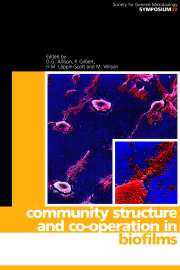Book contents
- Frontmatter
- Contents
- Contributors
- Editors' Preface
- An overview of biofilms as functional communities
- Initial microbial adhesion events: mechanisms and implications
- Physiological events in biofilm formation
- Environmental and genetic factors influencing biofilm structure
- Coaggregation and coadhesion in oral biofilms
- Cohesiveness in biofilm matrix polymers
- Microbial detachment from biofilms
- Modelling and predicting biofilm structure
- Microbial community interactions in biofilms
- Microbial communities: aggregates of individuals or co-ordinated systems
- Gene transfer in biofilms
- Population dynamics in microbial biofilms
- Biodegradation by biofilm communities
- Biofilms and prosthetic devices
- Biofilms: problems of control
- Biofilms in the New Millennium: musings from a peak in Xanadu
- Index
Coaggregation and coadhesion in oral biofilms
Published online by Cambridge University Press: 03 June 2010
- Frontmatter
- Contents
- Contributors
- Editors' Preface
- An overview of biofilms as functional communities
- Initial microbial adhesion events: mechanisms and implications
- Physiological events in biofilm formation
- Environmental and genetic factors influencing biofilm structure
- Coaggregation and coadhesion in oral biofilms
- Cohesiveness in biofilm matrix polymers
- Microbial detachment from biofilms
- Modelling and predicting biofilm structure
- Microbial community interactions in biofilms
- Microbial communities: aggregates of individuals or co-ordinated systems
- Gene transfer in biofilms
- Population dynamics in microbial biofilms
- Biodegradation by biofilm communities
- Biofilms and prosthetic devices
- Biofilms: problems of control
- Biofilms in the New Millennium: musings from a peak in Xanadu
- Index
Summary
COAGGREGATION AND COADHESION
Certain molecules on the surfaces of human oral bacteria can be recognized by cognate surface components of genetically distinct cells, which bind to form networks of cell–cell interactions. When these interactions occur in suspension, they are called coaggregations (Kolenbrander, 1988). When the interaction occurs between suspended or planktonic cells and already adherent cells, it is called coadhesion (Bos et al., 1994). Coadhesion may involve the accretion of an already formed coaggregate onto a biofilm, which is an assemblage of living cells on a substratum, or onto a virgin surface.
Coaggregation among human oral bacteria was first described 30 years ago (Gibbons & Nygaard, 1970). Coaggregation is measured by several methods, including visual inspection of clumps or coaggregates after mixing dense suspensions of two cell types (Gibbons & Nygaard, 1970), turbidometric measurement of supernatant after slowspeed centrifugation to pellet the coaggregates (McIntire et al., 1978), filtration through specific pore size to separate single cells from coaggregates (Lancy et al., 1980), distribution of radiolabelled cells of one cell type in coaggregates and supernatant after slow-speed centrifugation (Kolenbrander & Andersen, 1986) and binding of a radiolabelled cell type to partner cells immobilized on a nitrocellulose membrane (Lamont & Rosan, 1990). Coaggregations may be unimodal or bimodal (Kolenbrander, 1997). Unimodal coaggregations involve protease-sensitive molecules on the cell surface of one of the partners recognizing their cognate receptors (protease-insensitive) on the other partner's cell surface. Bimodal coaggregations involve more than one of the unimodal mechanisms. For example, one partner expresses both an adhesin and a non-cognate receptor. Its partner expresses the respective cognates for the adhesin and receptor.
- Type
- Chapter
- Information
- Community Structure and Co-operation in Biofilms , pp. 65 - 86Publisher: Cambridge University PressPrint publication year: 2000
- 14
- Cited by



